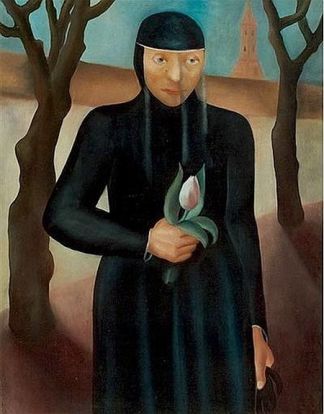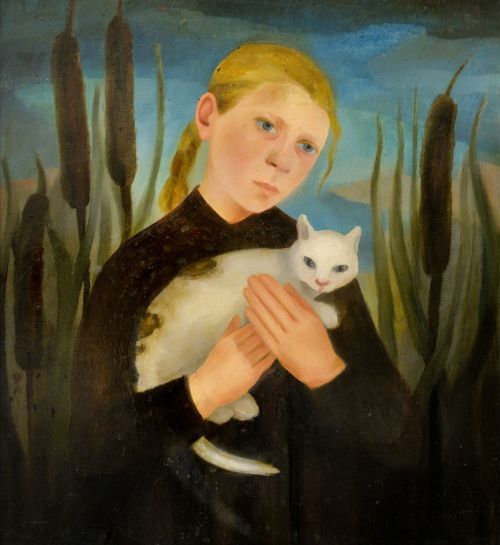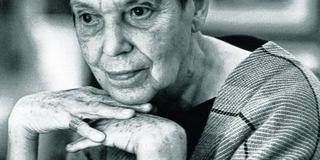Helen Torr (American, 1886-1967),

Helen Torr (American, 1886-1967),
Fall, 1935.
Oil on canvas, 18 x 20in (45.7 x 50.8cm). McNay Art Museum.
More Posts from Art0634 and Others

Willi Baumeister, Abstraktion (Konstruktion Rot-Oliv III), 1923
board on thin board
32.2 x 21.8 cm (12.6 x 8.5 in), board: 35,5 x 24 cm (13,9 x 9,4 in)

Byron Browne, Seated Woman, 1936
Mixed Media on paper
17 x 12 1/4 inches


The Light and the Dying
Artist: Gilliam Hornstein (American)
Date: 20th century
Medium: Oil on canvas
Collection: North Carolina Museum of Art, Raleigh, NC, United States

Pablo Picasso

Max Ernst, L’homme et la femme, Painted circa 1929-1930
oil on board
10 1/2 x 8 5/8 in. (26.7 x 21.8 cm.)
![Kazuo Shiraga (1924-2008) [Japan] — ‘Chiansei Kinhyoshi’, 1962. Oil On Canvas (195 X 130 Cm).](https://64.media.tumblr.com/44ea14f02c772236fd30b897b5f6b372/bac99c63dff7919a-15/s500x750/a25fa6ac87ad9be2fe6d10c9dfde018781abd42b.jpg)
Kazuo Shiraga (1924-2008) [Japan] — ‘Chiansei Kinhyoshi’, 1962. Oil on canvas (195 x 130 cm).

Creglingen by Carl Grossberg, 1926





Kate Diehn-Bitt (German, 1900-1978)
An automatic translation:“Born in Schöneberg near Berlin in 1900, Kate (originally: Käthe) Diehn-Bitt was a middle-class daughter. Her training took place exclusively in various private art schools; After early marriage and the birth of her son in 1920, she began studying at the – again – private art academy in Dresden in 1929–31, where Woldemar Winkler (1902–2004) became her teacher, who later described her as “a very clever one , very self-confident, emancipated personality”. The Dresden art scene around Otto Dix, Otto Griebel and others must have been as impressive for Diehn-Bitt as the political atmosphere in the city.
Back in Rostock, she set up her first studio in 1933; In 1935 she exhibited together with the sculptor Hertha von Guttenberg in the gallery of Wolfgang Gurlitt in Berlin - it would take until 1948 until another exhibition is dedicated to her in Schwerin.
During the Nazi era, Kate Diehn-Bitt’s stepfather, Dr. Leo Glaser persecuted as a Jew; she herself and her work were deemed “foreign”. After the end of the war, Diehn-Bitt was initially involved in cultural policy in the newly founded GDR, but after being sentenced to paint “not in a forward-looking or optimistic manner”, she withdrew from all functions in the 1950s and died in Rostock in 1978. All of the political-historical upheavals of the 20th century in Germany can be seen in her biography and work.”
https://www.kulturstiftung.de

On the Bridge, 1903 Edvard Munch
-
 dayywalker5 reblogged this · 2 months ago
dayywalker5 reblogged this · 2 months ago -
 dayywalker5 liked this · 2 months ago
dayywalker5 liked this · 2 months ago -
 kirkys-pretty-pictures reblogged this · 5 months ago
kirkys-pretty-pictures reblogged this · 5 months ago -
 putriddivine reblogged this · 6 months ago
putriddivine reblogged this · 6 months ago -
 u-mn liked this · 7 months ago
u-mn liked this · 7 months ago -
 grumpygitlikesart reblogged this · 7 months ago
grumpygitlikesart reblogged this · 7 months ago -
 jardaworksgallery liked this · 7 months ago
jardaworksgallery liked this · 7 months ago -
 babsrosette reblogged this · 8 months ago
babsrosette reblogged this · 8 months ago -
 artstorycollection reblogged this · 8 months ago
artstorycollection reblogged this · 8 months ago -
 look-and-find liked this · 8 months ago
look-and-find liked this · 8 months ago -
 trainsinthedistanceatnight reblogged this · 8 months ago
trainsinthedistanceatnight reblogged this · 8 months ago -
 jiffisquid liked this · 8 months ago
jiffisquid liked this · 8 months ago -
 andrea-69-2 reblogged this · 8 months ago
andrea-69-2 reblogged this · 8 months ago -
 andrea-69-2 liked this · 8 months ago
andrea-69-2 liked this · 8 months ago -
 idiviner liked this · 8 months ago
idiviner liked this · 8 months ago -
 throwaway-settings liked this · 8 months ago
throwaway-settings liked this · 8 months ago -
 theadaptableeducator liked this · 8 months ago
theadaptableeducator liked this · 8 months ago -
 dessaturated reblogged this · 8 months ago
dessaturated reblogged this · 8 months ago -
 art0634 reblogged this · 8 months ago
art0634 reblogged this · 8 months ago -
 art0634 liked this · 8 months ago
art0634 liked this · 8 months ago -
 sous-le-saule liked this · 8 months ago
sous-le-saule liked this · 8 months ago -
 grundoonmgnx reblogged this · 8 months ago
grundoonmgnx reblogged this · 8 months ago -
 dykecatboy reblogged this · 8 months ago
dykecatboy reblogged this · 8 months ago -
 504gilgamesh reblogged this · 8 months ago
504gilgamesh reblogged this · 8 months ago -
 504gilgamesh liked this · 8 months ago
504gilgamesh liked this · 8 months ago -
 fuckloveuhm liked this · 8 months ago
fuckloveuhm liked this · 8 months ago -
 kirkypet liked this · 8 months ago
kirkypet liked this · 8 months ago -
 jackwiant liked this · 8 months ago
jackwiant liked this · 8 months ago -
 grundoonmgnx liked this · 8 months ago
grundoonmgnx liked this · 8 months ago -
 warabou liked this · 8 months ago
warabou liked this · 8 months ago -
 dmorganillustration liked this · 8 months ago
dmorganillustration liked this · 8 months ago -
 from-smog liked this · 8 months ago
from-smog liked this · 8 months ago -
 ymutate reblogged this · 8 months ago
ymutate reblogged this · 8 months ago